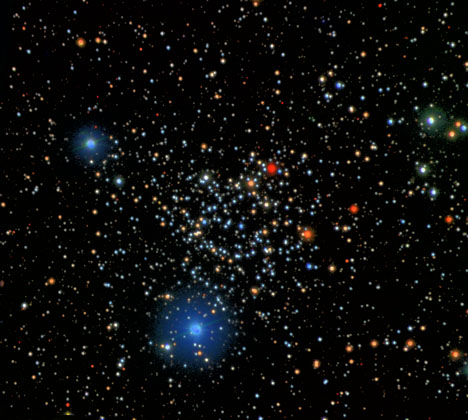

Open Cluster NGC 1245
| Date: | 21./22.10.1995 (V&I/B)
| Time: | 22:30 UT (V,I), 22:55 UT (B)
| Exposure: | B:85m, V:18m, I:5m
|
| Field of View: | 20.1' x 18.0'
| Receiver: | WWFPP, 20482 CCD
| Filter: | B, V, I
|
| Instrument: |
1.23m
| Observatory: |
Calar Alto
| Observer: | T. Credner, S. Kohle
|
© Copyright by the observers

Astronomical Institutes of the University of Bonn
From Colors to Astrophysics
This three color composite
is consisting of Johnson B, V, and
I filter exposures, represented in blue, green, and red respectively.
The composite is assembled with a
special technique to preserve and present the original physical
star colors.
The Open Star Cluster NGC 1245 has a distance of about 2.5 kpc in the direction
of the constellation Perseus.
Like in NGC 2194 most bright stars of the cluster show a slightly blue color.
These are the "normal" hydrogen core burning stars with their hot surface temperature.
But there are also a lot of bright orange stars. They are evolved, i.e. they
already left the usual stage of hydrogen core burning and started hydrogen
shell burning. Some might already burn helium in their cores.
The orange color is due to their cooler surface temperature.
The relative large number of these evolved stars is a hint for the old age of
the cluster. Indeed NGC 1245 is with 109 years about ten times
older than the cluster M 50, and so belongs like
NGC 2194 to the unusual population of old or intermediate age Open Clusters
in our Galaxy.
The two very bright blue stars are most probable foreground objects of the
galactic field, i.e. they are no cluster members.
1994A&A...289..397C, CARRARO, G.; PATAT, F., CCD BV photometry of the
intermediate age open cluster NGC 1245
Open Cluster Data 5th Edition (Lynga 1987) at CDS Strasbourg.
SEDS infos
